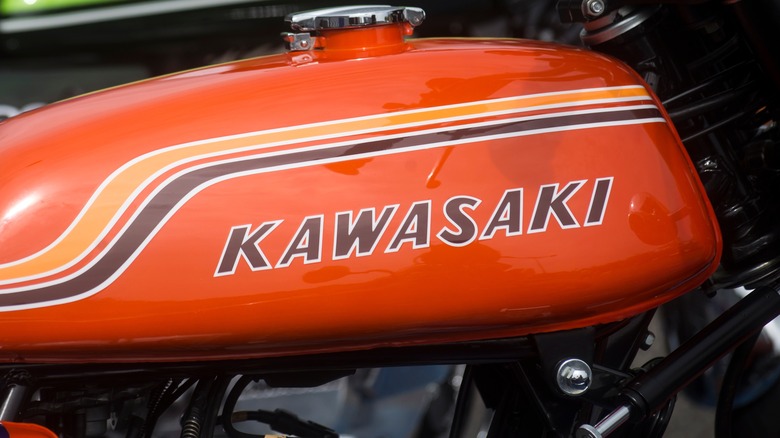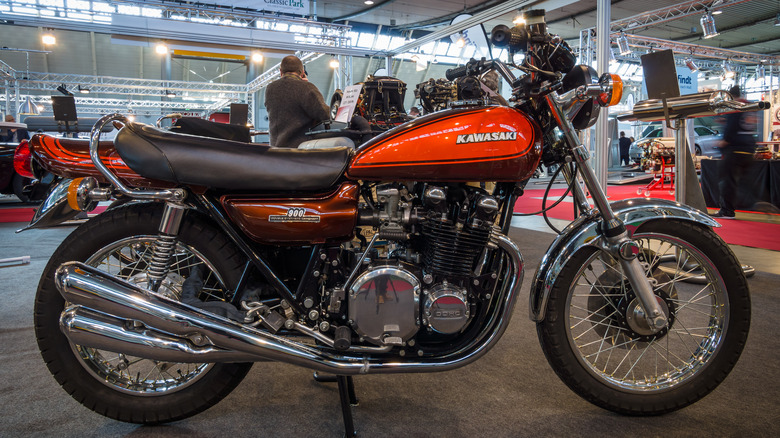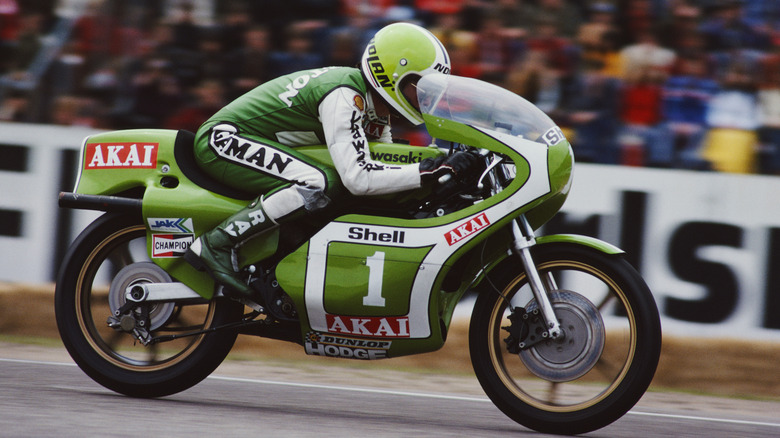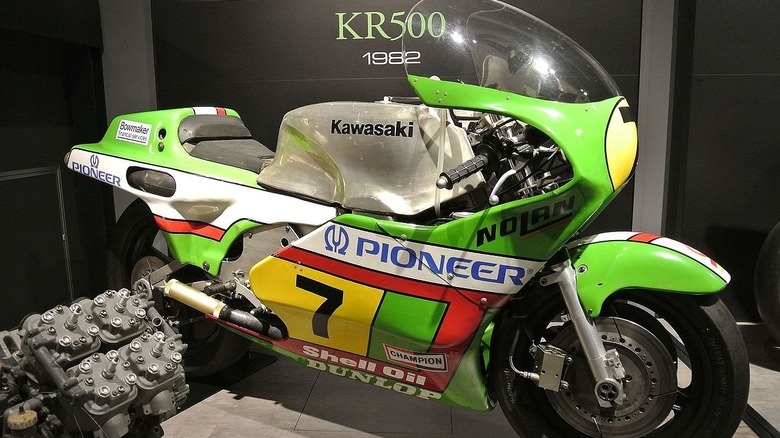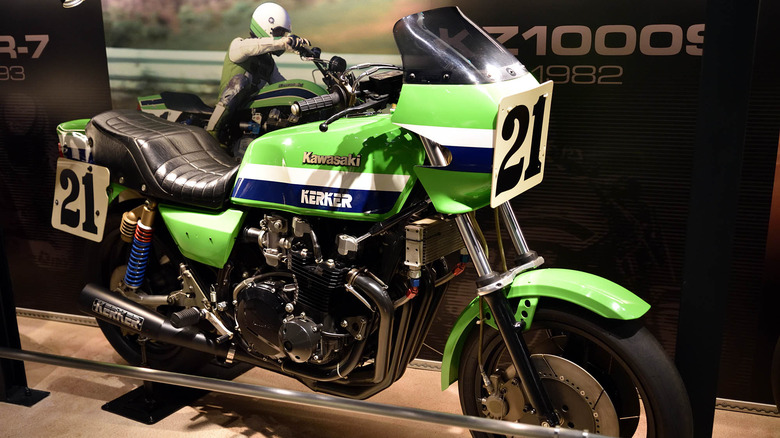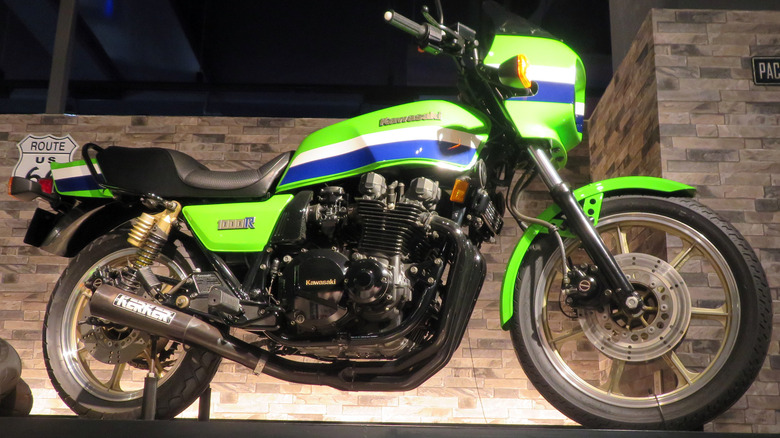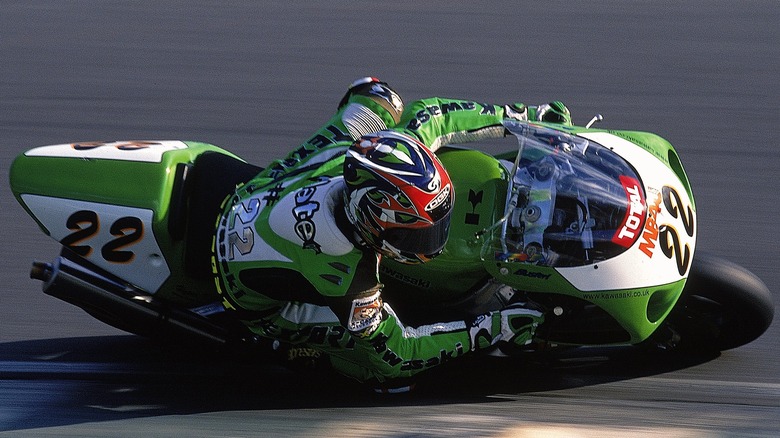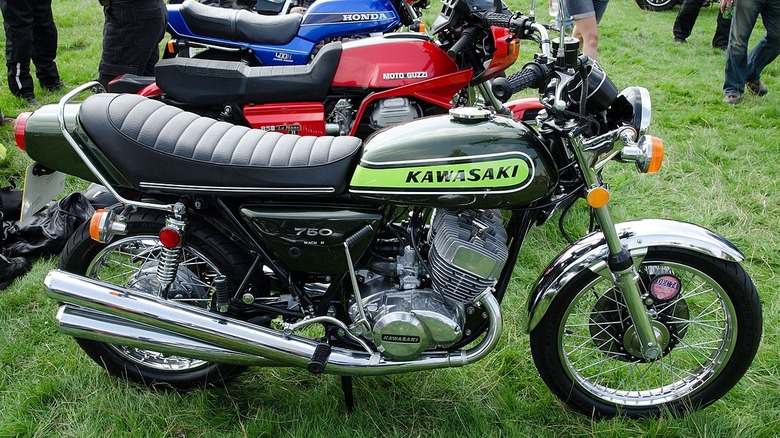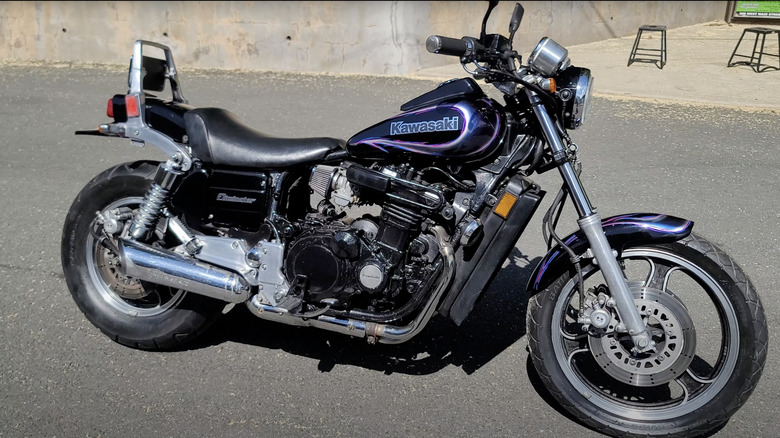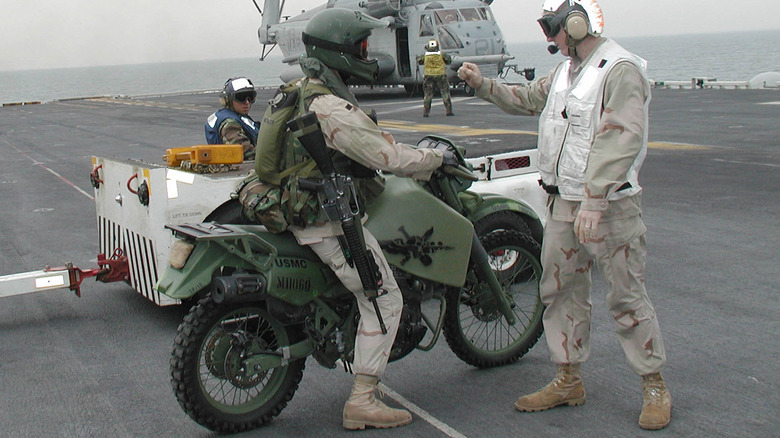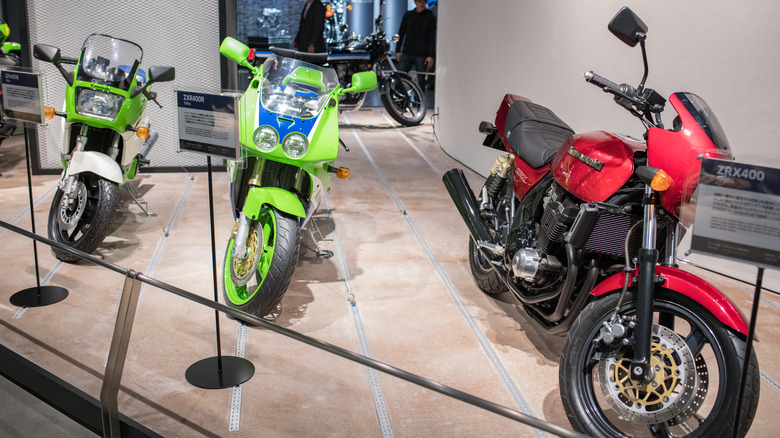10 Of The Rarest Kawasaki Motorcycles Ever Made (And What They're Worth Today)
Japanese automakers have a long history of industrial development. Like Mitsubishi, maker of the legendary Lancer Evo, Kawasaki began as a shipbuilding concern founded by Shozo Kawasaki in the late 1870s before expanding into heavy industry, producing ships, railroad equipment, and electrical generating equipment. After nearly a century of honing its engineering prowess, Kawasaki decided to add motorcycles to its vast network. In 1960, Kawasaki took over Meguro, a domestic motorcycle producer with an undeserved reputation for poor quality in foreign markets. A year later, it made its first model, the B8 125 cc two-stroke. More a scooter than a full-sized bike, the 11-hp B8 became popular for its inexpensive reliability.
Kawasaki made a splash in the racing world with a pair of Grand Prix World Championships in 1969 and 1978. And after years of further development, it introduced the first bike to carry the Ninja nameplate in 1984. The first liquid-cooled double overhead cam (DOHC) 16-valve four-cylinder was dubbed "Bike of the Year." Since then, Kawasaki hasn't let off the gas. The next few decades would see Kawa join the big four motorcycle manufacturers for market and performance supremacy, alongside Honda, Suzuki, Yamaha.
Over the last almost 80 years, Kawasaki has produced some legendary motorcycles, some of which have become rare and sought-after by collectors and enthusiasts. Join us as we look at some of the rarest Kawasaki motorcycles ever made and the prices they command today.
1973 Z1 — $16,000 to $55,000
By 1972, Kawasaki had already established itself as a reputable manufacturer of high-quality motorcycles. However, its ambition was not just to compete with other manufacturers, but to surpass them.
The original Kawasaki Z1 started life as one of the most potent and most eye-catching motorcycles Kawasaki had yet sent to the market. The term universal Japanese motorcycle (UJM) describes Japanese bike makers' lines of air-cooled, do-it-all bikes in the 1970s. Machines like the Honda CB750 and Suzuki GT750 could carry a rider on the daily commute or shred the pavement in weekend rides. The Z1 upended the UJM competition with its 1973 model
Heretofore, the UJM had been a relatively simple single-cam 750. Kawasaki's bike blew the lid off that thinking with a 903cc DOHC four-cylinder (the first of its kind) that took the crown as the fastest production motorcycle of the year. With the DOHC four-cylinder putting out 82 horsepower against a wet weight of 546 pounds, the Z1 had a top speed of 130 mph.
50 years later, the Z1's lineage can be found throughout Kawasaki's motorcycle production history. Its development spawned several bikes on this list, and put Kawasaki squarely in the performance competition game. Today, the Z1 is hardly ultra-rare, but Kawa fans who want the original game changer can be expected to shell out $16,000 or more for one in good condition. A matching numbers example sold at Mecum in January 2023 for $55,000!
KR250 — $65,000 to $117,000
With the 1969 Grand Prix under its belt, Kawasaki forged onward in the race world. The Kawasaki KR250 appeared in 1975 as a two-stroke tandem twin designed by engineer Nagato Sato. With rotary valves and a seven-speed gearbox, the KR250 was loud, vibrated heavily, and not particularly powerful, with somewhere in the range of 45-50 hp. Nonetheless, it made a big ripple on the racetrack.
Kawasaki scored a quartet of championships during the KR250's seven-year run — two with Kork Ballington in 1978 and 1979, and another back-to-back performance in 1980 and 1981 with Anton Mang in the saddle.
While Kawasaki produced several KR250 replicas, they were never made available in the European, North American, or U.K. markets, adding to their allure. However, an original KR250 is a true gem even among these rare replicas. The 1975 race bike, once ridden by Yvon Duhamel, is currently up for sale at Mecum with a price tag of $65,000. And if you're a true enthusiast, you might be interested in the actual World Championship-winning machine, listed by rider Kork Ballington for 92,000 pounds (about $117,000).
KR500 — $76,000 to $100,000
With experience in the 250 and 350 classes during the 1970s, Kawasaki decided to extrapolate what made the KR250 effective into the 500cc class. Engineers laid out blueprints and began building the KR500 -– a two-stroke four-cylinder –- in 1979. While it shared some design qualities with baby brother, like rotary valves, the alloy monocoque chassis differed from the older bike.
The KR500 never achieved the success of the KR250. Maligned as too heavy and unable to compete with the technological innovations of Honda and Yamaha, Kawasaki managed to score a few podiums before withdrawing from GP racing after 1982.
The KR500 only had half the production cycle of the KR250, making it even more difficult to find an authentic race bike. Only four are believed to have survived the era: one in a private collection in England, one in the Kawasaki museum, one in the United States, and one in the hands of former Kawasaki rider Kork Ballington, who personally raced it.
As you might imagine, finding one of the four for sale is challenging, but a 1982 Kawasaki KR500 recently went to the auction block with a price estimate of $76,000 to $100,000.
1983 KZ1000R ELR – $10,000 to $20,000+
In honor of winning the 1981 AMA Superbike championship, Kawasaki developed an Eddie Lawson Replica (ELR) KZ1000R for the 1983 production year. It was a transitional time in motorcycle technology, with UJMs like the CB750 and GS1000 giving way to the candy-colored super sports in just a few years.
The Z designation had been in the Kawasaki lineup since 1972 (and lives today in some of Kawasaki's expert-level bikes). By the arrival of the ELR, Kawa was making Zs in 650, 750, and 1000 cc displacements. But there would be only one Eddie Lawson Replica — a Frankenstein of a KZ1000 and a GPz 1100 modified just as Eddie liked it.
With a stepped seat, handlebars customized to Eddie's preference, magnesium wheels, 313mm four-piston brakes, and over 79 hp in a 544-pound (247-kg) package, the KZ1000R ELR hearkens to the days of the UJM while hinting at the then-future of racing with snappy fairings and that distinctive Kawasaki green pop.
Kawasaki only built 750 1982 ELRs, changing the name to Superbike Replica model upon his departure for Yamaha the following year. With technological advancement outpacing production processes, the ELR did not sell particularly well. It was outdated almost as fast as it hit the showroom floor.
Today, the KZ1000R ELR has become a collector's item amongst Kawasaki aficionados. While the price tag may not be eye-popping, at between $10,000 and $20,000 for original specimens, it's a big ask for a bike over forty years old.
KZ1000R-S1 $100,000+
The KZ1000R Eddie Lawson Replica may not bust a flush Kawa fan's wallet, but it produced an even rarer offspring that just might. While the ELR was a tribute to the racing great, a hardcore racebike was in the offing.
After Lawson's AMA Superbike championship, Kawasaki engineers shipped the bike to a research facility to find out what worked and how to improve it. The result was the KZ1000R-S1, a pure racer made for professionals but (barely) available to the public. Intended for the KMC racing team, Kawasaki only produced about 30 of the bikes, some of which went to a selection of Superbike sponsoring American dealers. Kawasaki sold the ultra-rare bike to dealers for $10,999 without guidance on the proposed retail price. Anybody who found one could buy it and hit the streets.
The mechanical differences included dual spark plugs, a massive oil cooler, Keihin CR carburetors, and a hand-fabricated aluminum swingarm. Anyone who wanted one would have had to know someone in the industry and cough up the scratch to buy it, but it would have made an excellent investment. As recently as 2013, an eBay auction netted $107,200 for an original.
ZX-7RR — $25,000
By the late '90s, full-fairing racebikes littered the racing landscape, and fans could buy some pretty gnarly street bikes that weren't far from the genuine article. The 1984 GPZ900R brought the Ninja nomenclature to Kawasaki's lineup. By the arrival of the ZX-7R in 1996, ZX meant one thing: blinding speed.
Today, the ZX-7RR looks dated in the most deliciously nostalgic way. Double-rounded headlights, a swept-back windshield, and full-fairing sleekness mark it as the evolutionary link between the superbikes of the '80s and the supersonic supersports of the early 2000s. The 1996 ZX-7RR was a homologation special born from the ZXR750K.
The extra R derives from several improvements over the ZX-7R, including an adjustable steering head and swingarm pivot, six-piston calipers on the front brake, a performance gearbox, and an upgraded suspension. The 1996 edition was the first Kawasaki bike to get trademark purple wheels, which aid in locating them on a racetrack covered with green bikes.
Not to be confused with the ZX-7R, the RR was a solo-seat sprinter. Only 500 ever left the factory, so finding one today is akin to locating a specific drop of water in the Tsushima Strait. While a Ninja with only one R in its name might net a few grand, the RRs demand more, with a 2021 auction seeing one go for $25,250.
H2 Mach IV — $40,000 to $55,000
It should come as little surprise that a motorcycle nicknamed the "Widowmaker" might not have many surviving examples a half-century after its inception. The 1972 Kawasaki Mach IV H2 (if the H2 rings a bell, it should: The Kawasaki Ninja H2R is legendary) had a reputation for being unfriendly to the novice rider.
The triple-cylinder 750cc two-stroke burst onto the scene in 1972. Despite — or perhaps because of — a brief production run of only a few years, the H2 Mach IV has endured in the minds of those who saw it hit the streets in real-time. As the name suggests, the H2 was built upon an earlier bike, the H1, a 500cc two-stroke. Compared to some bikes on this list, the H2 Mach IV supply was virtually limitless, with 47,000 made.
Though the Widowmaker may have earned its nickname a tad unjustly, it certainly lives on as the pinnacle of street bike insanity and a representative of a time long past. Two-stroke street bikes just don't happen anymore and haven't for a long time.
A recent spate of bidding wars has recalibrated the market for these classic smokers. A 1973 model commanded $42,000 at a Bring-A-Trailer auction in 2022, and it doesn't seem like things are cooling down: A January 2024 Mecum auction saw one reach a high water mark of $55,000.
ZL900 — $2,800
With the Yamaha V-Max, Honda V65 Magna, and Suzuki GV1200 Madura entering the market in the mid-80s, Kawasaki stepped up with its own muscle drag bike. The short-lived ZL900 employed the GPX900R's four-stroke, liquid-cooled, 16-valve DOHC superbike engine. Wrapped in a cruiser frame with a 62-inch wheelbase and a slightly raked front end and driven by shaft rather than chain, the in-line-four's 105 hp tangled admirably with the 1100cc and 1200cc V4s fielded by its competitors.
Introduced in 1985 as the ZL900A1 and available in 1986 as the ZL900A2, this streetfighter's life span was exceedingly short. After two years, Kawasaki replaced it with a thousand cc model that eliminated some Spartan muscle bike aspects, such as the drag-style handlebars and exposed rear wheel.
Unlike most bikes on this list, the ZL900s have not increased in value due to their rarity. Kelly Blue Book pins the value of a 1985 ZL900 in good condition at a paltry $2,835. That's not because it was a lousy bike; it just got lost amidst V4 competition and constantly changing bike market. Heck, maybe it's a future classic. Pick one up now and cross your fingers that it grows into the Ferrari 250 GTO of the future! Even if it doesn't, you'll still have a powerful and comfortable vintage Kawa in the fleet.
KL650-A HDT Military — around $15,000
Special operations units like the Navy SEALs have given us some awesome vehicles to play with. When the military needs something specific, it often contracts a manufacturer to make it how they like. Such is the case with the Kawasaki KLR650. Wait a second? A KLR650, what's so special about that? Well, this one runs on jet fuel.
Logistics are one of the most critical aspects of a successful military operation. You can't fight if you don't have fuel. And with the myriad machines the U.S. takes into battle, that means a lot of different kinds of fuel. Enter Hayes Diversified Technologies. At the behest of the U.S. military back around the turn of the millennium, Hayes took a KLR650 and converted the top end into a liquid-cool single cylinder that could run on everything from biodiesel to kerosene to jet fuel.
Calling the KL650-A a rousing success would be a bit of an exaggeration. Only about 200 made it through production, and the ones that did saw a hard life getting beaten by hard-charging combat troops. The survivors are pretty rare, but they have gotten some attention from content creators and collectors. Mecum auctioned one off back in April of 2023 for $15,000. Hardly a six-figure sum, but a lot for what is essentially a curiosity.
Ar80 — $2,200
Kawasaki has built as many styles of bike as it has participated in races. One offspring of Kawa's wild imagination is the Ar80 Cafe Racer. The two-stroke, single-cylinder 80cc bike was only made between 1981 and 1983. We can see why — the whole thing looks like a motorcycle equivalent of what happens when a chihuahua mates with an English border collie: Weird angles and off-looking features, but definitely still a dog.
With a flat cafe racer-style seat and a full fairing windshield stretched on either end of a tiny engine, the whole appeal must be the power, right? Yes, all 10 hp and 6 lb-ft of torque. This thing looks like Lloyd Christmas Carrey and Harry Dunne should be clutching each other on it on their way to Aspen.
These odd little bikes are exceedingly rare, especially in America, which barely saw any imports. Unfortunately for the one guy reading this who has one in his shed, they're not particularly valuable. One sold at auction in 2021 for $2,200.
